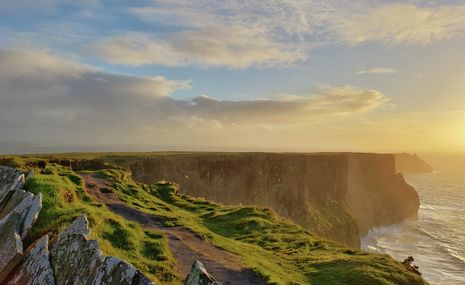The Banshees of Inisherin: What’s all this fighting about?
In McDonagh’s tragicomedy, friends falling out becomes an undeniably canny allegory for the Irish Civil War

Fallings-out happen all the time: they are felt like festering wounds, are tender to touch and stubborn to heal. Down the line, we pick at the scabs they form and trace their scars with regret. But while physical injury is rarely without a clear cause, The Banshees of Inisherin explores how the injuries we sustain in our relationships often elude simple explanations.
Martin McDonagh’s latest tragicomedy stars two of his most frequent collaborators, Colin Farrell and Brendon Gleeson, as seen together in 2008’s In Bruges, and has so far been navigating a gilded path through this year’s awards season.
Set against the backdrop of the Irish Civil War, The Banshees of Inisherin follows friends Colm and Pádraic as they struggle to navigate the devastating consequences of a sudden and unexpected feud.
Every day at 2pm, for as long as anyone can remember, the old pals have met for a pint at the pub. It’s a tale of male friendship as old as time. Yet, for all their closeness, the two make an unlikely pair: Pádraic is a kind-hearted dairy farmer, content with the simple pleasures of life on Inisherin, while Colm (the instigator of the feud) is a skilled fiddler with little time for meaningless conversation and a burgeoning desire to leave a lasting legacy.
Colm becomes steadfast in his sudden refusal to associate with Pádraic; almost as steadfast as Pádraic is in his refusal to accept Colm’s decision. Farrell is at his best here, playing Pádraic like a doleful puppy, so used to playing fetch that he has formed an unshakeable habit of placing a ball at his owner’s feet. So, Colm delivers a chilling ultimatum: every time his old friend bothers him, he will take to his fiddling hand with a pair of shears and slice off one finger.
“In a moment that is a tad on-the-nose, Pádraic concedes that he doesn’t know what they’re fighting about”
There is no gasp-inducing betrayal nor long-plotted revenge; Colm’s reasoning is cruelly arbitrary: “I just don’t like ya no more”.
This principal conflict is what makes Banshees so compelling. It’s a mundane anticlimax that frustrates the usual cause-effect chain that audiences have come to expect. So much about it doesn’t make sense: why go to such extreme lengths? And, as Pádraic himself protests, he liked him yesterday — so what changed?
And so, the mundane becomes joined by the nonsensical. Bloodied, dismembered fingers quite literally go flying, while the inane and repetitive homosocial interactions play like scenes from Waiting for Godot. This combination of Tarantino-esque violence with the absurd dramatic sensibilities of Beckett is McDonagh’s recipe for the perfect tragicomedy. The film’s screenplay is peppered with fast-paced and witty dialogue, while lighter comedic moments give way to heightened unease accompanying instances of drowning, arson and manslaughter (or more accurately donkey-slaughter).
Although definitive interpretations of the film’s meaning will differ, Colm and Pádraic’s relationship is an undeniably canny allegory for the civil war in which it’s situated. Yes, the inhabitants of Inisherin are for the most part ignorant of the violence raging on the mainland, but it’s made conspicuous in small acts and small talk: from a red paintbox painted green, to the distant sounds of gunfire. In a moment that is a tad on-the-nose, Pádraic concedes that he doesn’t know what they’re fighting about. As audience members, we’re not certain what he and Colm are fighting about either.
Personal conflict, then, plays out as a symbol for wider war and disagreement: brothers taking up arms against brothers, and inflicting wounds too deep to close. Colm’s self-mutilation in particular takes on new meaning in this light, symbolic of the self-destructive nature of the civil war: a country that is ultimately fighting, or mutilating, itself.
When Colm remarks that the violence may soon subside, Pádraic disagrees: there are some things there’s just no moving on from.
 Features / The forgotten family member: Oxbridge College sisterhood12 February 2025
Features / The forgotten family member: Oxbridge College sisterhood12 February 2025 Comment / Why Oxbridge’s offers day matters10 February 2025
Comment / Why Oxbridge’s offers day matters10 February 2025 News / Pembroke’s TikTok famous Director of Music steps down from role 12 February 2025
News / Pembroke’s TikTok famous Director of Music steps down from role 12 February 2025 Comment / There is a hypocrisy of tolerance here at Cambridge14 February 2025
Comment / There is a hypocrisy of tolerance here at Cambridge14 February 2025 News / News in brief: Rowing, research, and a royal documentary11 February 2025
News / News in brief: Rowing, research, and a royal documentary11 February 2025





